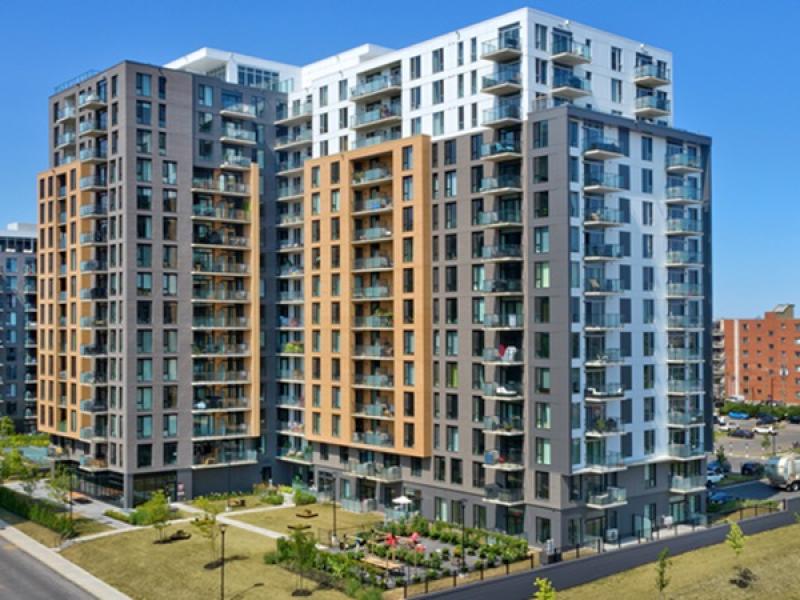
The twin towers of Concord Canada House are considered the “crown jewel” of the massive CityPlace development in downtown Toronto, Concord Pacific says. (Courtesy Concord Pacific)
As the end of a quarter-century odyssey looms, Concord Pacific received a chance to reflect on the past, present and future of Toronto’s largest master-planned community, CityPlace, during a recent Urban Land Institute Toronto webinar.
Concord Pacific acquired the former Railway Lands, southwest of Toronto’s financial core, in 1997 and is nearing completion of the massive 31-tower project.
Concord Adex development vice-president Gabriel Leung (Concord Adex is a subsidiary of Concord Pacific) opened the proceedings by reciting some facts and figures about CityPlace, a 55-acre site bordered by Bathurst Street to the west, Lake Shore Boulevard to the south, Front Street to the north and Blue Jays Way and Rogers Centre to the east.
CityPlace encompasses 9.5 million square feet of development. At buildout, the 31 towers will contain 12,000 units housing 21,000 residents as well as 120,000 square feet of retail, two day-care centres for 124 children, two schools, a community centre, a library and an eight-acre park.
Twenty-nine towers are complete and most of the site has been developed.
Eighty-one per cent of CityPlace residents are between the ages of 25 and 44. Twenty-three per cent of them have pets.
CityPlace has a Walk Score of 96 due to its central location and 39 per cent of its residents walk to work. The average household income is $124,000.
History of the CityPlace site
Greenberg Consultants Inc. principal Ken Greenberg — an urban designer, city-building advocate and author — provided a historical perspective on the CityPlace site.
It was part of 200 acres of what was called Canadian National’s Railway Lands, which were used as marshalling yards before it was decided to convert them to more urban uses in the mid-1960s.
Part of the land was used in the 1970s for the CN Tower, while a massive project called The Metro Centre was cancelled.
The Metro Toronto Convention Centre and SkyDome (now Rogers Centre) were built in the 1980s and the Air Canada Centre (now Scotiabank Arena) followed a decade later.
Greenberg was involved with the site in the 1980s when he was appointed director of architecture and urban design. It was decided the land shouldn’t be isolated, but be tied into the rest of the city through integrated streets and become a community.
Greenberg said Marathon Realty, the real estate arm of Canadian Pacific Railway, and CN Realty didn’t believe residential development would be successful. Instead, they wanted the land to be used for office and business purposes.
City of Toronto director of community planning Lynda Macdonald became heavily involved with the site after Concord Adex purchased it, with a vision to create a master-planned community with a large multiresidential component utilizing a tower-and-podium approach.
“This pre-dated development charges, so there was a development levy regime that was developed that kind of looked at what the demand was going to be and therefore what services the developer should pay for,” said Macdonald.
Leung said there were concerns CityPlace would be cut off from the rest of the community and even as recently as 10 years ago some people were concerned that it would become a “ghetto.”
The evolution of CityPlace
Concord Adex has paid for all the community infrastructure, a $14-million public art program, a bridge across railway tracks to connect CityPlace to the neighbourhood to the north, parks and roads, and provided land to the city for affordable housing.
“We wanted to bring a fresher vision to what an urban master-planned community could be like,” said Leung, who acknowledged CityPlace was a long-term project with a long-term vision.
Concord Adex used different architects to express different building styles and paid a lot of attention to the retail aspect of the development.
It carefully selected tenants and focused on having appropriately designed, scaled, sized and located retail and commercial space, as well as patio areas for restaurants, to make the street-level experience as animated as possible for residents and passersby.
“We have been engaging retail consultants right off the bat and working with architects to create more emphasis on better retail at grade and making the grade more vibrant,” said Leung.
Macdonald said there are about 10,000 more people living in CityPlace than planned 20 years ago, which has put pressure on community services in the neighbourhood.
Plans haven’t fundamentally changed, she noted, but fine-tuning has been done to the public realm’s relationship with buildings, increased porosity and placing an emphasis on retail that serves the community.
More families than expected
It was originally expected young singles and couples would live at CityPlace until they had enough money to move and raise their families. That hasn’t necessarily been the case, as many children and teenagers now live in the neighbourhood.
Leung said 12 per cent of CityPlace residents have children. Each unit has an average of 1.9 people living in it and 67 per cent of units have two or more residents.
Twenty-five per cent of CityPlace residents have lived there for five years or more and 35 per cent plan to stay for at least another five years, according to Leung.
CityPlace also exceeds municipal requirements that 10 per cent of units have three bedrooms, a mandate that didn’t exist in the early days of the development’s planning.
Leung said the 55 per cent renter/45 per cent owner composition of condominium residents hasn’t changed much over the years.
He noted Concord Adex doesn’t make a conscious effort to chase the speculative market and reaches out to the brokerage community to appeal to end-users, but acknowledged few end-users want to wait for five years until a building can be built and delivered.
Community involvement and support at CityPlace
Concord Adex has worked with City of Toronto representatives, the CityPlace Residents’ Association, the CityPlace Fort York BIA and other organizations to be mindful of people’s wants and needs and create events and amenities to make the community as vibrant as possible, according to Leung.
Dean Maher moved into CityPlace in 2003 and founded the CityPlace Residents’ Association. While he felt residents were often neglected by city representatives, he said Concord Adex has been responsive and a big supporter.
CityPlace Fort York BIA is a small one, with fewer than 100 businesses. Chair Jesse Topliffe, who has raised a young family in CityPlace, said engagement with Concord Adex has been critical to the organization’s success and has provided financial support in addition to the funds it receives through a levy.
Businesses in CityPlace and the nearby Fort York neighbourhood have done relatively well despite the negative impact of the pandemic due to the population density in the area. That’s something businesses in the financial core haven’t benefited from, according to Topliffe.
Still to come at CityPlace
Concord Canada House is under construction at 23 Spadina Ave. and is expected to be completed in two years. It will include two condo towers with almost 1,400 units.
CityPlace will also add affordable housing at 150 Queens Wharf Rd. CreateTO, the City of Toronto’s real estate arm, has proposed the construction of a 29-storey building with 282 rental units. It will be the last tower constructed at CityPlace.
A project under the Gardiner Expressway that will be used for a unique retail and community experience is also planned.











